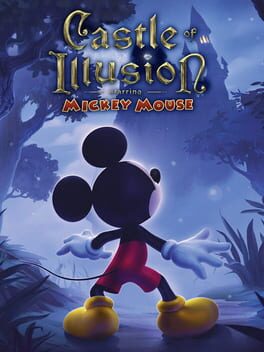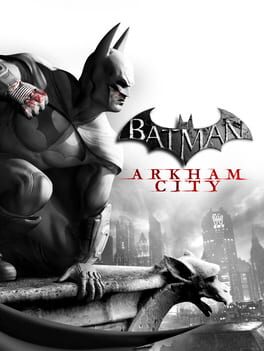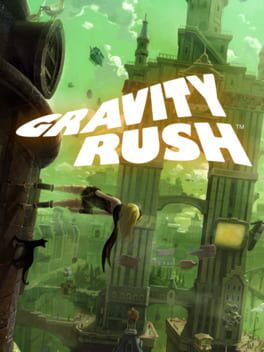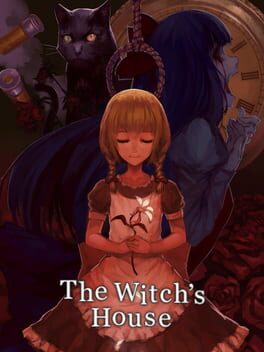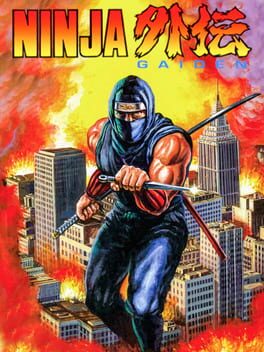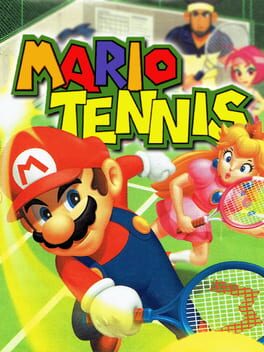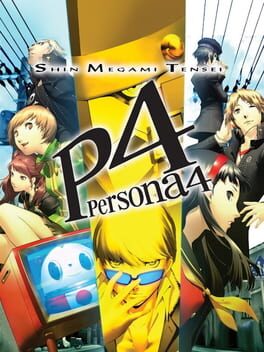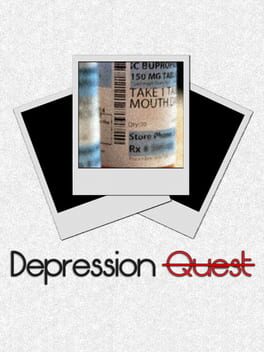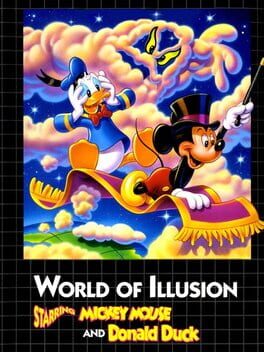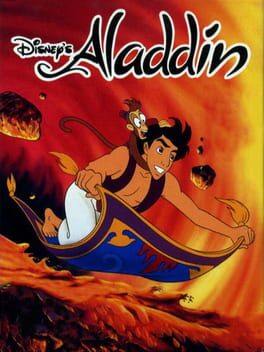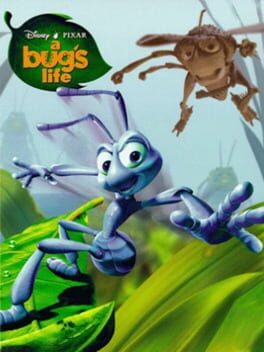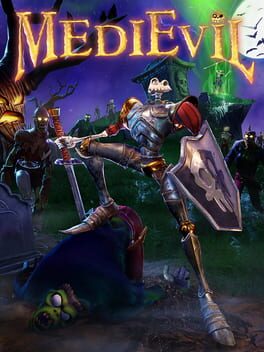MacBlank
Pretty faithful remake of the original, down to its limited and super simple design. Visuals get a nice update, with a lot of the reimagined levels feeling alive. Still retains the weird pacing choices of having five levels for seven MacGuffins. Mizrabel's completely overhauled fight is a neat change of pace.
NONE OF THAT MATTERS. You play this game for the added narrator. Holy moly, does the narrator add so much to this experience. It's so simple yet so inspired, having this guy throw in fun little lines describing what Mickey's doing or thinking at each given moment. You might think that that's redundant or messing with the original's tonality or something, but I don't think so! Talking about Mickey having to be brave or the illusory monsters he has to fight or whatever is exactly the sort of thing that would've pulled me into this game as a kid. This is the sort of thing I want to see added to this endless conga line of remakes we're getting these days.
My very favorite line (paraphrased, since it's been a bit)- "Mickey remembered the advice his friend Donald gave him on adventures: never have them."
NONE OF THAT MATTERS. You play this game for the added narrator. Holy moly, does the narrator add so much to this experience. It's so simple yet so inspired, having this guy throw in fun little lines describing what Mickey's doing or thinking at each given moment. You might think that that's redundant or messing with the original's tonality or something, but I don't think so! Talking about Mickey having to be brave or the illusory monsters he has to fight or whatever is exactly the sort of thing that would've pulled me into this game as a kid. This is the sort of thing I want to see added to this endless conga line of remakes we're getting these days.
My very favorite line (paraphrased, since it's been a bit)- "Mickey remembered the advice his friend Donald gave him on adventures: never have them."
2011
I loved Arkham Asylum, but I only "liked" Arkham City. The deciding factor for me is what I suspect other people really love about City: the open world layout of the titular city. I actually think having an overworld to freely explore de-emphasizes a lot of the tight pacing and level design that I really appreciated in Asylum. Is it fun to be swooping around the city and suddenly find yourself drawn into a subplot involving Jarvis Teech? Sure, I suppose I won't contest that. But most of my experience of the titular city is that it's the no-man's land of video game miscellany. Some thugs to fight, some Riddler trophies to collect, mostly things for the player to distract themselves from the main plotline.
If you're into that, cool, you're probably someone who gets a ton out of what Rocksteady was going for here. If not, well, you don't have to do all that. You can just ignore all the unscripted sequences and bop on over to the next storybeat... at the opposite end of the map. For whatever reason, the game really likes placing a lot of its key locations on opposite ends of the overworld's "V" shape. And at a certain point, swinging back and forth ignoring shouts of distress, I sorta shattered the illusion the first game so meticulously set up and stopped feeling like the Caped Crusader.
Look, my point is, there are a ton of memorable moments to Arkham City, but almost none of them actually take place in the overworld.
But those subareas are quite good! The Cyrus Pinkney Natural History Institute is full of fun rooms and set-pieces. The Mr. Freeze boss fight is incredibly well-designed, even if it isn't particularly subtle ("AH SO BATMAN HAS THE ABILITY TO CRASH THROUGH WINDOWS! NOW I KNOW NOT TO WALK TOO CLOSE TO WINDOWS! YOU CAN'T FOOL ME THE SAME WAY TWICE BATMAN!"). Ra's al Ghul feels like a complete sidetrack, but it's a nice change of pace. The final area also lends itself to some good combat rooms, and the final encounter... well, I kinda think Arkham was 0 for 2 with final bosses, but I like how it ends.
Catwoman's fun, too! Her segments are over and done with pretty quickly, but they make for nice diversions. Sorta wish you could do more with her, but w/e. That fakeout bad ending is quite the shock if you actually go for it.
So, like, I got my issues with Arkham City, but I still think it's a fine enough time. I'm given to understand later Arkhams continue to move further away from what I liked about the first game (I have Arkham Knight, just need to get around to it). That's a bummer for me, but if it's what people like, who am I to say no?
...that GAME OF THE YEAR EDITION "10 OUT OF 10" boxart is still utterly ridiculous, though. Are we in agreement on that?
If you're into that, cool, you're probably someone who gets a ton out of what Rocksteady was going for here. If not, well, you don't have to do all that. You can just ignore all the unscripted sequences and bop on over to the next storybeat... at the opposite end of the map. For whatever reason, the game really likes placing a lot of its key locations on opposite ends of the overworld's "V" shape. And at a certain point, swinging back and forth ignoring shouts of distress, I sorta shattered the illusion the first game so meticulously set up and stopped feeling like the Caped Crusader.
Look, my point is, there are a ton of memorable moments to Arkham City, but almost none of them actually take place in the overworld.
But those subareas are quite good! The Cyrus Pinkney Natural History Institute is full of fun rooms and set-pieces. The Mr. Freeze boss fight is incredibly well-designed, even if it isn't particularly subtle ("AH SO BATMAN HAS THE ABILITY TO CRASH THROUGH WINDOWS! NOW I KNOW NOT TO WALK TOO CLOSE TO WINDOWS! YOU CAN'T FOOL ME THE SAME WAY TWICE BATMAN!"). Ra's al Ghul feels like a complete sidetrack, but it's a nice change of pace. The final area also lends itself to some good combat rooms, and the final encounter... well, I kinda think Arkham was 0 for 2 with final bosses, but I like how it ends.
Catwoman's fun, too! Her segments are over and done with pretty quickly, but they make for nice diversions. Sorta wish you could do more with her, but w/e. That fakeout bad ending is quite the shock if you actually go for it.
So, like, I got my issues with Arkham City, but I still think it's a fine enough time. I'm given to understand later Arkhams continue to move further away from what I liked about the first game (I have Arkham Knight, just need to get around to it). That's a bummer for me, but if it's what people like, who am I to say no?
...that GAME OF THE YEAR EDITION "10 OUT OF 10" boxart is still utterly ridiculous, though. Are we in agreement on that?
I played the remake first, which naturally dampened what I got out of the original. But the original ain't bad either. Simple, but not bad.
This is probably a pretty decent "baby's first platformer". It's pretty straightforward, with the main nuances being Mickey's slow, floaty movement and his projectile game. The game is very forgiving, though not a complete gimme - Continues are limited. I respect that you still have to put some effort in to learn stuff, even if the remake suggests that this is less a deliberate choice on SEGA's part and more a natural consequence of expected game design.
The game sure doesn't feel much like a Mickey Mouse title. If it wasn't for Mickey and Minnie, and Mizrabel kinda looking like Snow White's Evil Queen, you could mistake this as being any sort of generic cutesy fantasy platformer. But I guess it's all right in its own respect. Animation on Mickey's pretty solid, anyway, even if it's a far cry from Virgin's later efforts.
It'd always been weird to me that there are only five levels but seven collectables. Like so you have the Rainbow Gems, implying seven, but you don't have a full set of seven levels to make up for them? Why not come up with some other theming and make the Gems a set of five, then? Odd stuff.
Even on just the Genesis, I'd probably take any other Disney title, but I can respect this being pretty impressive if you were a kid in a pre-Sonic world.
This is probably a pretty decent "baby's first platformer". It's pretty straightforward, with the main nuances being Mickey's slow, floaty movement and his projectile game. The game is very forgiving, though not a complete gimme - Continues are limited. I respect that you still have to put some effort in to learn stuff, even if the remake suggests that this is less a deliberate choice on SEGA's part and more a natural consequence of expected game design.
The game sure doesn't feel much like a Mickey Mouse title. If it wasn't for Mickey and Minnie, and Mizrabel kinda looking like Snow White's Evil Queen, you could mistake this as being any sort of generic cutesy fantasy platformer. But I guess it's all right in its own respect. Animation on Mickey's pretty solid, anyway, even if it's a far cry from Virgin's later efforts.
It'd always been weird to me that there are only five levels but seven collectables. Like so you have the Rainbow Gems, implying seven, but you don't have a full set of seven levels to make up for them? Why not come up with some other theming and make the Gems a set of five, then? Odd stuff.
Even on just the Genesis, I'd probably take any other Disney title, but I can respect this being pretty impressive if you were a kid in a pre-Sonic world.
2012
The first Gravity Rush is a modest, basic little game carried entirely by two things: the strength of its player character, and the strength of its moveset.
To touch upon the latter first, Gravity Shifting is deceptively one of the most fun abilities a video game has ever offered a player. It doesn't seem like it at first, because it feels quite awkward. Jump into the air and hit the button to go Zero Gravity. Rotate your camera - either with the buttons or the Vita's build-in gyroscope - and hit the button again to shift gravity. You will now fall in the wrong direction. You may readjust if you'd like, but after a certain amount of time, you will start falling in the right direction.
It's weird and clumsy and will absolutely result in Kat zooming in weird directions or falling flat on her face. But eventually you realize, "Oh, wait! This is flight! It's purely physics-based flight!" And then you start to experiment with things like momentum and chaining Gravity Slides into Shifts, and you really start to see Hekseville as the playground it was designed to be. It helps also how forgiving the game is with missed targets and depleted meters, since it's usually pretty easy to loop back around and that meter recharges super quickly (in mid-air!), especially once you have a couple upgrades under your belt. Even if you happen to fall out of bounds, it's no big deal - Dusty will swoop in to bring Kat back into the game, no worse for wear.
I will say, Gravity Shifting definitely felt like it was missing something in this game. It gets a lot of mileage out of Shifting, Sliding, Kicking, and the Stasis Field, but there's a certain je ne sais quoi absent. This would be addressed in Gravity Rush 2, but here Kat's moveset is "only" great. Still one of those games where the mere act of moving around the world as the main character feels right.
Speaking of the main character, holy moly is Kat great. She's such an unabashedly wholesome and sweet (if a little self-centered) protagonist, something you don't expect on first blush with her character design. Her defining moment for me has always been "Home Sweet Home", an early mission where the amnesiac Kat decides her first order of business upon arriving in an unfamiliar city is to find a place to live. She ends up finding a disused sewage run-off pipe and is delighted, then flies around town finding garbage to decorate it. One montage later, the kid's actually set up a pretty sweet pad for herself, and you'll see her relaxing there every time you save or boot the game up.
Every story this game tells is filtered through the lens of this character, who doesn't seem to realize the gravity (heh) of most of the situations she ends up in. So while the plot goes in a lot of directions that, frankly, I can't keep up with, it's always told through the very grounded, simple-minded perspective of its main character. Helps make the whole thing more fun.
Like... she successfully convinces hardened gang members to stop being gang members by asking nicely. What more do you want from your lead?
I had the good fortune to play this game during the year I had free access to PlayStation Plus, and this ended up being one of my runaway favorites from that year. You're generally better off playing the PS4 port these days, but don't overlook this release, either.
To touch upon the latter first, Gravity Shifting is deceptively one of the most fun abilities a video game has ever offered a player. It doesn't seem like it at first, because it feels quite awkward. Jump into the air and hit the button to go Zero Gravity. Rotate your camera - either with the buttons or the Vita's build-in gyroscope - and hit the button again to shift gravity. You will now fall in the wrong direction. You may readjust if you'd like, but after a certain amount of time, you will start falling in the right direction.
It's weird and clumsy and will absolutely result in Kat zooming in weird directions or falling flat on her face. But eventually you realize, "Oh, wait! This is flight! It's purely physics-based flight!" And then you start to experiment with things like momentum and chaining Gravity Slides into Shifts, and you really start to see Hekseville as the playground it was designed to be. It helps also how forgiving the game is with missed targets and depleted meters, since it's usually pretty easy to loop back around and that meter recharges super quickly (in mid-air!), especially once you have a couple upgrades under your belt. Even if you happen to fall out of bounds, it's no big deal - Dusty will swoop in to bring Kat back into the game, no worse for wear.
I will say, Gravity Shifting definitely felt like it was missing something in this game. It gets a lot of mileage out of Shifting, Sliding, Kicking, and the Stasis Field, but there's a certain je ne sais quoi absent. This would be addressed in Gravity Rush 2, but here Kat's moveset is "only" great. Still one of those games where the mere act of moving around the world as the main character feels right.
Speaking of the main character, holy moly is Kat great. She's such an unabashedly wholesome and sweet (if a little self-centered) protagonist, something you don't expect on first blush with her character design. Her defining moment for me has always been "Home Sweet Home", an early mission where the amnesiac Kat decides her first order of business upon arriving in an unfamiliar city is to find a place to live. She ends up finding a disused sewage run-off pipe and is delighted, then flies around town finding garbage to decorate it. One montage later, the kid's actually set up a pretty sweet pad for herself, and you'll see her relaxing there every time you save or boot the game up.
Every story this game tells is filtered through the lens of this character, who doesn't seem to realize the gravity (heh) of most of the situations she ends up in. So while the plot goes in a lot of directions that, frankly, I can't keep up with, it's always told through the very grounded, simple-minded perspective of its main character. Helps make the whole thing more fun.
Like... she successfully convinces hardened gang members to stop being gang members by asking nicely. What more do you want from your lead?
I had the good fortune to play this game during the year I had free access to PlayStation Plus, and this ended up being one of my runaway favorites from that year. You're generally better off playing the PS4 port these days, but don't overlook this release, either.
2012
Part of a Japanese indie RPG Maker horror trilogy that has long existed in my head, alongside Ib and Mad Father. I know "trilogy" isn't quite right; the only real throughline these games have are similar game engines (Mad Father isn't even in RPG Maker) and translator. And anyway, if we're going by that logic, vgperson has handled way more stuff than just those three games. No matter; the trilogy in my head is Ib, Witch's House, and Mad Father. I played Ib many years ago, and now I've played Witch's House.
The Witch's House is predicated entirely around its ending reveal. There is other interstitial stuff that composes the rest of the experience, but the narrative thrust sits entirely within the ending. It's a good ending reveal, don't get me wrong, but the consequence is that everything leading up to it sort of feels irrelevant. Now, since the game's only an hour or so long, that isn't really that much of a strike against it - but it does make the experience feel lopsided in retrospect.
This isn't to say that the grand majority of the game is without merit. I think as a tonal piece, the game's at its strongest earlier on, when you're just doing some unsettling puzzles and the house is starting to go crazy. The third floor in particular is delightfully dark, with great setup and payoff. On the flipside, I kinda think any of the jump-scare chase sequences come across as ridiculous - particularly that giant skull on the fifth floor - but then I've always thought stuff like Ao Oni was more silly than scary.
Yeah, here's where I admit that indie horror projects like this have never been my bag. When I play one of these, the main thing I'm looking for is mood and tone, not spoopiness. I think, since I highlighted it before, I resonated a lot more with Ib when I played that years ago, since that had a lot more consistent tonality and theming between its gameplay and narrative. Witch's House is fine enough, good for its duration, but it isn't really something that sticks with me outside a couple moments and its ending. Its gameplay moments feel more like a fantasia of horror that only occasionally interacts with the character and story moments. No disrespect if that's the stuff that hooked you onto the game, but it isn't personally my thing.
The Witch's House is predicated entirely around its ending reveal. There is other interstitial stuff that composes the rest of the experience, but the narrative thrust sits entirely within the ending. It's a good ending reveal, don't get me wrong, but the consequence is that everything leading up to it sort of feels irrelevant. Now, since the game's only an hour or so long, that isn't really that much of a strike against it - but it does make the experience feel lopsided in retrospect.
This isn't to say that the grand majority of the game is without merit. I think as a tonal piece, the game's at its strongest earlier on, when you're just doing some unsettling puzzles and the house is starting to go crazy. The third floor in particular is delightfully dark, with great setup and payoff. On the flipside, I kinda think any of the jump-scare chase sequences come across as ridiculous - particularly that giant skull on the fifth floor - but then I've always thought stuff like Ao Oni was more silly than scary.
Yeah, here's where I admit that indie horror projects like this have never been my bag. When I play one of these, the main thing I'm looking for is mood and tone, not spoopiness. I think, since I highlighted it before, I resonated a lot more with Ib when I played that years ago, since that had a lot more consistent tonality and theming between its gameplay and narrative. Witch's House is fine enough, good for its duration, but it isn't really something that sticks with me outside a couple moments and its ending. Its gameplay moments feel more like a fantasia of horror that only occasionally interacts with the character and story moments. No disrespect if that's the stuff that hooked you onto the game, but it isn't personally my thing.
1988
For a game/series notorious for its difficulty, it's striking that the original Ninja Gaiden doesn't really get difficult until the tail end. Like it's never easy, but it doesn't get really hard until Stage 5-2/5-3 or so. Of course, the game then gets downright dickish with 6-2 and completely cruel with 6-4, so the game's reputation is well-earned. I just think it's neat that the player is most of the way into the game before the gloves come off. Gives the sense that you can do it, you've already come this far, you just have to rise to the occasion.
(For the record, the only time I called B.S. is having to restart a loop after botching a run on the final boss. Though, I think it's an interesting concession that the game remembers what phase you were on with the final boss between loops. My solution was to savestate at the end of 6-3, reload saves until I cleared a phase, then redo the loop, saving again at the end of 6-3. You can insist I did not beat the god damn game if you must, but that seemed the fairest compromise that still let me feel some of the intended effect.)
Nah, Ninja Gaiden represents probably the closest you could come to a spectacle platformer on the NES. In a lot of ways, Ninja Gaiden feels like a counterpart to the original Castlevania: same brutality, same subweapon system, same love of mean flying enemies, same way of encouraging the player to try again with endless continues. The main difference of course being that Ninja Gaiden is a FAST game, with Ryu Hayabusa being ridiculously agile in sharp contrast to Simon Belmont's plodding slowness.
But while Castlevania merely wears its love for movies on its sleeve, Ninja Gaiden is an early adopter of video game cutscenes. It's not the first - Pac-Man and Ms. Pac-Man predate it, of course. But you have to love how proud TECMO was of what they were doing, judging by the manual boasting of the game's unique "Cinema Display" system. Plus you gotta love stuff like Ryu dismissing Irene with "Just a girl. Get out of here!", only for Irene to immediately tranq him.
There's a lot of great tonality and presentation to Ninja Gaiden, too. A lot of it is genre work familiar to ninja movies - though, again, seeing any of that in this era is pretty cool - but there's a good amount baked into the cadence of the gameplay. The sheer focus on game world continuity through its level design - how every level starting with Stage 4-1 flows into the next, down to it all being visible in that one shot of Ryu looking at the far-off mountain - is cool.
Plus, there's the striking choice of the game's main theme - "Unbreakable Determination" - first appearing in Stage 4-2, long after most games introduce and iterate upon their leitmotifs. Really gives the sense that everything to that point was prelude, and the real adventure begins there. Considering that's also around when the game starts getting harder, it's justified.
Famously, the game is as hard as it is because the developers got too familiar with it, and kept spicing it up to keep themselves challenged. But I think that also goes to show the sheer confidence and respect the team had for what they were doing. Very much a game worth playing and studying, even today.
(For the record, the only time I called B.S. is having to restart a loop after botching a run on the final boss. Though, I think it's an interesting concession that the game remembers what phase you were on with the final boss between loops. My solution was to savestate at the end of 6-3, reload saves until I cleared a phase, then redo the loop, saving again at the end of 6-3. You can insist I did not beat the god damn game if you must, but that seemed the fairest compromise that still let me feel some of the intended effect.)
Nah, Ninja Gaiden represents probably the closest you could come to a spectacle platformer on the NES. In a lot of ways, Ninja Gaiden feels like a counterpart to the original Castlevania: same brutality, same subweapon system, same love of mean flying enemies, same way of encouraging the player to try again with endless continues. The main difference of course being that Ninja Gaiden is a FAST game, with Ryu Hayabusa being ridiculously agile in sharp contrast to Simon Belmont's plodding slowness.
But while Castlevania merely wears its love for movies on its sleeve, Ninja Gaiden is an early adopter of video game cutscenes. It's not the first - Pac-Man and Ms. Pac-Man predate it, of course. But you have to love how proud TECMO was of what they were doing, judging by the manual boasting of the game's unique "Cinema Display" system. Plus you gotta love stuff like Ryu dismissing Irene with "Just a girl. Get out of here!", only for Irene to immediately tranq him.
There's a lot of great tonality and presentation to Ninja Gaiden, too. A lot of it is genre work familiar to ninja movies - though, again, seeing any of that in this era is pretty cool - but there's a good amount baked into the cadence of the gameplay. The sheer focus on game world continuity through its level design - how every level starting with Stage 4-1 flows into the next, down to it all being visible in that one shot of Ryu looking at the far-off mountain - is cool.
Plus, there's the striking choice of the game's main theme - "Unbreakable Determination" - first appearing in Stage 4-2, long after most games introduce and iterate upon their leitmotifs. Really gives the sense that everything to that point was prelude, and the real adventure begins there. Considering that's also around when the game starts getting harder, it's justified.
Famously, the game is as hard as it is because the developers got too familiar with it, and kept spicing it up to keep themselves challenged. But I think that also goes to show the sheer confidence and respect the team had for what they were doing. Very much a game worth playing and studying, even today.
2000
I’m given to understand that Camelot’s handheld golf outings are actually quite good. They’re the basis for the excellent Golf Story, after all - little RPG narrative adventures where you build up the player character’s stats over the course of a fun golf training arc. I think Mario Tennis GBC is going for the same sorta thing, but as it turns out, the effect doesn’t translate across sports.
It bears mention before getting into what Tennis GBC does with its campaign: the main issue at play with this game is how rough the AI is. It’s actually extremely easy to cheese it here, particularly in Singles: do a drop shot to one corner of the court, then either smash a return or do a lob shot to the opposite side. The AI naturally responds to the drop shot by running up to hit it, and most AI opponents lack the reach or speed to respond to this trickery. Once you figure out how to do this, and once you fall into a good cadence with this, most opponents are helpless before you.
It turns out that this is sort of a blessing in disguise. Annoyingly, the standard match length in the game’s story is 3 Sets, 6 Games per Set. For comparison, console Mario Tennis I don’t think ever forces the player to do more than 2 game Sets? Starting out the gate with best of 3 Sets and moving into Best of 5 Sets just feels like padding. I don’t even really like it when console Mario Tennis does that, but the gameflow is at least fast enough in console tennis that a climactic 3- or 5-Set Match feels like a well-paced struggle. Everything moves sooooo sloooooowly on GBC.
You also gain EXP and stats from minigames rather than standard tournament play, so you’re expected to intersperse these slow-ass games with slow-ass grinding sessions. In my experience, Mario Tennis GBC ended up being something to play while I had something else on out of necessity; I actually spent a decent amount of time playing this while meeting up with some out-of-state friends, while we were just loafing around and watching TV. I sort of have fond memories of the game for that reason, but boy does the game not earn it.
Speaking of earning things, you have to earn the right to get Mario characters into the game’s primary narrative! You spend most of the time in a rookie-to-success string of tournament arcs amid OCs, and it’s only after you clear the final tournament that you get the privilege of traveling to the Mario World to face off against interdimensional tennis superstar Mario (and Peach, in Doubles). I don’t necessarily object to relegating the Mario cast to legendary figures you have to earn the right to play against, but there ends up being no references to Mario until the credits roll like two or three times, grinding out the campaign. It’s a very curious decision to make in a game called Mario Tennis.
And it’s hardly the most important thing, but since Tennis is such a limited sport compared to Golf, it takes to having stapled-on RPG stats a lot less elegantly than Golf does. I know I would’ve ground things out, but for the life of me I can’t remember what nuance these stats added, on top of making me able to compete with the higher-end foes.
Looking at what the game offers, I’m willing to accept that I’m inherently missing something by playing Mario Tennis GBC in a vacuum, as a lot of its side content ties in to connecting the game with the N64 console version (transferring characters and mini-games, etc). I think of how it goes for Pokémon Stadium, where the intention is that the console game benefits from its connectivity with the handheld game. But Pokémon Stadium still represents a largely complete experience even without the handheld games. I guess Mario Tennis GBC can stand alone, but there's so little to it that if you're not inherently sold on the core loop of playing slow tennis with some dude against easily-duped boofheads, you're just wasting your time. Too bad.
It bears mention before getting into what Tennis GBC does with its campaign: the main issue at play with this game is how rough the AI is. It’s actually extremely easy to cheese it here, particularly in Singles: do a drop shot to one corner of the court, then either smash a return or do a lob shot to the opposite side. The AI naturally responds to the drop shot by running up to hit it, and most AI opponents lack the reach or speed to respond to this trickery. Once you figure out how to do this, and once you fall into a good cadence with this, most opponents are helpless before you.
It turns out that this is sort of a blessing in disguise. Annoyingly, the standard match length in the game’s story is 3 Sets, 6 Games per Set. For comparison, console Mario Tennis I don’t think ever forces the player to do more than 2 game Sets? Starting out the gate with best of 3 Sets and moving into Best of 5 Sets just feels like padding. I don’t even really like it when console Mario Tennis does that, but the gameflow is at least fast enough in console tennis that a climactic 3- or 5-Set Match feels like a well-paced struggle. Everything moves sooooo sloooooowly on GBC.
You also gain EXP and stats from minigames rather than standard tournament play, so you’re expected to intersperse these slow-ass games with slow-ass grinding sessions. In my experience, Mario Tennis GBC ended up being something to play while I had something else on out of necessity; I actually spent a decent amount of time playing this while meeting up with some out-of-state friends, while we were just loafing around and watching TV. I sort of have fond memories of the game for that reason, but boy does the game not earn it.
Speaking of earning things, you have to earn the right to get Mario characters into the game’s primary narrative! You spend most of the time in a rookie-to-success string of tournament arcs amid OCs, and it’s only after you clear the final tournament that you get the privilege of traveling to the Mario World to face off against interdimensional tennis superstar Mario (and Peach, in Doubles). I don’t necessarily object to relegating the Mario cast to legendary figures you have to earn the right to play against, but there ends up being no references to Mario until the credits roll like two or three times, grinding out the campaign. It’s a very curious decision to make in a game called Mario Tennis.
And it’s hardly the most important thing, but since Tennis is such a limited sport compared to Golf, it takes to having stapled-on RPG stats a lot less elegantly than Golf does. I know I would’ve ground things out, but for the life of me I can’t remember what nuance these stats added, on top of making me able to compete with the higher-end foes.
Looking at what the game offers, I’m willing to accept that I’m inherently missing something by playing Mario Tennis GBC in a vacuum, as a lot of its side content ties in to connecting the game with the N64 console version (transferring characters and mini-games, etc). I think of how it goes for Pokémon Stadium, where the intention is that the console game benefits from its connectivity with the handheld game. But Pokémon Stadium still represents a largely complete experience even without the handheld games. I guess Mario Tennis GBC can stand alone, but there's so little to it that if you're not inherently sold on the core loop of playing slow tennis with some dude against easily-duped boofheads, you're just wasting your time. Too bad.
2008
2013
This review contains spoilers
I don't really want to have a conversation on this game. At the same time, I have a set of criteria for the games I talk about on Backloggd, and Depression Quest meets them: it's a game I've completed, I know when I completed it, and I am confident of my opinions on it. Actually, while I wouldn't call it a favorite by any means, I did find I ultimately connected with it, enough so that I still catch myself thinking about it now and again. Because of that, it's important to me that I somehow preserve those opinions.
After thinking about it for a while, I've decided I'm just going to present my opinions as isolated bullet points. No further summation, no point I want to drive at, just my naked opinions.
- It was very polite to release this game for free following Robin Williams' suicide
- Presenting choices, then striking them out and blocking the player from selecting them, is an effective analogy for experiencing crippling depression
- The moment where the player character is able to notice his hands shaking as a consequence of his bottled up tension, and that awareness of physical response to mental stimuli, is a familiar turning point for... a lot of things, in my experience
- I appreciate that the player can choose whether to address depression through drugs or therapy. I appreciate as well that neither is more correct, and each respective approach has its own ramifications.
- Adopting a kitten - and thus having another life to care for, as a means of combatting depression - is also familiar.
- I have no desire whatsoever to revisit this game to explore less-than-best endings and see what commentary the game holds there. Having said that...
- I am given to understand that the worst ending explains that the player character has given up on life but is too unmotivated to commit suicide; regardless, no happy ending is possible for him. I don't know if this is the text of the game. This is just what I have read elsewhere. Assuming this is true, I have mixed feelings on this. I do not want anything in this world to contribute to suicide rates, and I respect an artist trying to steer clear of that. At the same time, it would represent the lone pulled punch in a game that otherwise has an extremely frank conversation about depression.
After thinking about it for a while, I've decided I'm just going to present my opinions as isolated bullet points. No further summation, no point I want to drive at, just my naked opinions.
- It was very polite to release this game for free following Robin Williams' suicide
- Presenting choices, then striking them out and blocking the player from selecting them, is an effective analogy for experiencing crippling depression
- The moment where the player character is able to notice his hands shaking as a consequence of his bottled up tension, and that awareness of physical response to mental stimuli, is a familiar turning point for... a lot of things, in my experience
- I appreciate that the player can choose whether to address depression through drugs or therapy. I appreciate as well that neither is more correct, and each respective approach has its own ramifications.
- Adopting a kitten - and thus having another life to care for, as a means of combatting depression - is also familiar.
- I have no desire whatsoever to revisit this game to explore less-than-best endings and see what commentary the game holds there. Having said that...
- I am given to understand that the worst ending explains that the player character has given up on life but is too unmotivated to commit suicide; regardless, no happy ending is possible for him. I don't know if this is the text of the game. This is just what I have read elsewhere. Assuming this is true, I have mixed feelings on this. I do not want anything in this world to contribute to suicide rates, and I respect an artist trying to steer clear of that. At the same time, it would represent the lone pulled punch in a game that otherwise has an extremely frank conversation about depression.
This one's a bit more my speed than Castle of Illusion. Though I'll admit, this game's lack of a central hub area like how last game had Mizrabel's Castle gives the game less of a cohesive through-line. Like yeah, Mizrabel's Castle barely mattered, but it was at least something to tether the adventure together. This time around, since I didn't have an instruction manual or anything, I found myself playing levels until I hit a boss I recognized in Pete, then credits rolled. Very abrupt.
(Actually, reviewing this game, I completely forgot that one of the bosses was Mad Madam Mim! I'd have thought that at least would've stuck with me.)
But the moment to moment stuff is more engaging. Adding Donald as a playable option of course nets the game easy points in my book. But I particularly respect that the game has different routes for a Mickey playthrough vs a Donald playthrough, then an entirely different set of levels for a co-op playthrough. I only played as Donald myself, so I fully acknowledge that I haven't gotten the full experience. Still, that's honestly quite cool that the game has that much going on under the hood.
I also respect the general magic motif here. It doesn't fully have me - the spells seem like context-sensitive functions, and while that's cool for a kid, it's just a device here to progress levels rather than a big mechanics change. But I do like the theming. As with the last game, there's a lot of creativity at display with the different level themes. That one underwater level, where our hero is surrounded by a bubble and gets an updated set of sprites, is a neat touch.
I think I look at World of Illusion along the same lines as the original Castle of Illusion: decent game, good entry-level title, not a lot of complexity for an adult but a decent enough time for a kid. Maybe co-op's solid, too. Since I like World of Illusion a bit more, it is a bit of a bummer that it never got a remake in the same vein as Castle of Illusion. But not anything that occupies a lot of my mental energy either way.
(Actually, reviewing this game, I completely forgot that one of the bosses was Mad Madam Mim! I'd have thought that at least would've stuck with me.)
But the moment to moment stuff is more engaging. Adding Donald as a playable option of course nets the game easy points in my book. But I particularly respect that the game has different routes for a Mickey playthrough vs a Donald playthrough, then an entirely different set of levels for a co-op playthrough. I only played as Donald myself, so I fully acknowledge that I haven't gotten the full experience. Still, that's honestly quite cool that the game has that much going on under the hood.
I also respect the general magic motif here. It doesn't fully have me - the spells seem like context-sensitive functions, and while that's cool for a kid, it's just a device here to progress levels rather than a big mechanics change. But I do like the theming. As with the last game, there's a lot of creativity at display with the different level themes. That one underwater level, where our hero is surrounded by a bubble and gets an updated set of sprites, is a neat touch.
I think I look at World of Illusion along the same lines as the original Castle of Illusion: decent game, good entry-level title, not a lot of complexity for an adult but a decent enough time for a kid. Maybe co-op's solid, too. Since I like World of Illusion a bit more, it is a bit of a bummer that it never got a remake in the same vein as Castle of Illusion. But not anything that occupies a lot of my mental energy either way.
2009
L4D2 is one of my most-played games, and something I come back to all the time with my Sunday night group. I can't claim mastery since we basically only play on Easy or Normal, but I'm at least very, very, very, very, very familiar with the core maps. It tends to be my Sunday night group's gold standard for games, and it's the title we come back to more often than anything else.
Admittedly, I don't think there's much more the game has to offer for me, at least from a vanilla experience. I'll play it with friends and family, because I like spending time with friends and family, but I'd generally be happier playing something else. Not an indictment on L4D2 (goodness knows I haven't played everything the game has to offer), just where I'm at.
But it's my group's gold standard for a reason. Sometimes we just need a simple, arcade-y co-op experience to jump into, and L4D2 has us covered. L4D2 isn't without strategy, far from it, and the randomization element of the horde encounters means there's generally a different angle to approach each run of a map. I like a lot of what L4D2 offers over the original game mechanically: I am basically useless if my secondary weapon is a handgun instead of a melee weapon, crescendo events are a lot more dynamic and varied compared to the first game, the new Special Infected are... annoying, but they're doing their job of keeping you on your toes... and I like all of the new maps, especially Hard Rain. I also like the cast and Southern setting way more than the first game's New England offerings, but that's more down to taste.
Admittedly, I don't think there's much more the game has to offer for me, at least from a vanilla experience. I'll play it with friends and family, because I like spending time with friends and family, but I'd generally be happier playing something else. Not an indictment on L4D2 (goodness knows I haven't played everything the game has to offer), just where I'm at.
But it's my group's gold standard for a reason. Sometimes we just need a simple, arcade-y co-op experience to jump into, and L4D2 has us covered. L4D2 isn't without strategy, far from it, and the randomization element of the horde encounters means there's generally a different angle to approach each run of a map. I like a lot of what L4D2 offers over the original game mechanically: I am basically useless if my secondary weapon is a handgun instead of a melee weapon, crescendo events are a lot more dynamic and varied compared to the first game, the new Special Infected are... annoying, but they're doing their job of keeping you on your toes... and I like all of the new maps, especially Hard Rain. I also like the cast and Southern setting way more than the first game's New England offerings, but that's more down to taste.
1994
It's trying really hard to be the Genesis game on Game Boy. In some respects that's commendable, but it's obvious that the Game Boy wasn't geared to handle it. The only way the team found to translate that Disney animation onto handheld was to sloooowwwww the game speed down to accommodate all the extra frames. Levels are fairly minimally updated, so a lot of sequences that benefitted from the extra screen real estate are now needlessly tricky and leap-of-faith-y. This of course means levels that were already dickish like "The Escape" are just even meaner this time around. I do think a better call would've been to take more of the approach Dark Techologies did later on with The Lion King, where the general ideas of these levels are preserved but updates are made to account for the reduced screen space, etc. Not good, but it's at least over and done with quickly enough with the Disney Classics Collection port and its special features.
My last Mario RPG for ages was Super Paper Mario (I didn't like Partners in Time, so after Super Paper, I just had no interest in pursuing later MaRPGios), so this was a chance to see what I'd been missing. Origami King had just come out, and I'd been inundated with discourse surrounding Sticker Star for years, but I actually knew little of what to expect for Color Splash. More of what people disliked about Sticker Star?
Well... probably... but I do think it's a fine enough game on its own.
The main thing is that you basically have to treat Paper Mario before and after Sticker Star as different series. A shared aesthetic lineage, to be sure, but the goals of each sub-sub-series is so different as to be incomparable. Color Splash has no interest in matching the world-building of Paper Mario, the scope of Thousand Year Door, or the tragedy of Super Paper; it just wants to be a silly series of incidental adventures with some Mario characters. And that's perfectly fine! I don't need every game to be a deceptively expansive RPG or anything like that. Simple li'l adventurey deckbuilders are okay, too.
Not that combat is especially interesting. Deckbuilding at least naturally encourages the player to experiment with the standard cards, but there really aren't too many, and you're likely to settle into something after a while. The ridiculously-named "Things" are the main bit of spice, essentially being one-off summons. They're... I guess it's cute how they change things up, but being one-and-done, it's hard to get real jazzed up about experimenting with them, especially knowing that some puzzles and some fights require some of the Things, and it's not always telegraphed what you'll need. You can at least grind 'em out if you need one you already used, but, like... was this really the easiest way to handle this mechanic?
Nah, you're definitely mostly here for the scenarios and writing. And there's a good deal of variety there! To name a few, there's a pirate adventure, a [muffled Shy Guy voice] BATTLE ROYALE, a Metal Gear Solid-esque infiltration sequence, a cooking challenge... to my knowledge, this is even the first Mario game to have the dubious honor of a Hot Springs Episode. Not to bring up a tired conversation point, but would this all be better with distinct Paper Mario OCs? Perhaps, but I'd argue that it's more effective in some ways to have some no-name Shy Guy randomly confide in Mario his own existentialist ennui. Anyway, it's fun to see how this game develops established supporting members of the Mario cast. Being a former Lemmy's Land Tourist, I'll frankly take any characterization I can for the Koopalings. And Birdo's reinvention as a lounge singer just... feels right for her. Definitely my current headcanon for her day job.
Also, without giving it away - the Green Power Plant was such a cool surprise. Holy moly.
My main emotional takeaway from this game is that it ended at precisely the right time. I had a lot of fun with its scenarios, and its mechanics were enough to lead me through them, but I think any longer - even one or two more stages - and the game would've worn out its welcome. Maybe that's a sign that tracking down each and every one of those Toads was a bit much? Whatever the case, while I definitely am more of a fan of the original Paper Mario series, this at least showed me that modern Paper Mario has its own merits. Solid enough time.
P.S., Thank you for remembering the Super Mario Land Staff Roll theme existed, game.
P.P.S., Another entry for the "when the hell else will I be able to recount this" list. This was my first regular livestreamed game for Designing For (viewable here), following our experiment with Live-A-Live. I didn't already own it, so I ordered a physical copy off GameStop's website (since I generally prefer physical media as a rule). I was confused when the disc wouldn't work on my Wii U, like the console simply couldn't read the disc. I had to check over and over again before I finally caught it - inexplicably, I'd received the German copy of the game in the mail from GameStop, and my Wii U was region-locked. I actually did try looking for a copy at physical stores (while observing social distancing, this being in the middle of COVID), but I ultimately just bought the game digitally off Wii U eShop. Still own that German copy, tho.
Well... probably... but I do think it's a fine enough game on its own.
The main thing is that you basically have to treat Paper Mario before and after Sticker Star as different series. A shared aesthetic lineage, to be sure, but the goals of each sub-sub-series is so different as to be incomparable. Color Splash has no interest in matching the world-building of Paper Mario, the scope of Thousand Year Door, or the tragedy of Super Paper; it just wants to be a silly series of incidental adventures with some Mario characters. And that's perfectly fine! I don't need every game to be a deceptively expansive RPG or anything like that. Simple li'l adventurey deckbuilders are okay, too.
Not that combat is especially interesting. Deckbuilding at least naturally encourages the player to experiment with the standard cards, but there really aren't too many, and you're likely to settle into something after a while. The ridiculously-named "Things" are the main bit of spice, essentially being one-off summons. They're... I guess it's cute how they change things up, but being one-and-done, it's hard to get real jazzed up about experimenting with them, especially knowing that some puzzles and some fights require some of the Things, and it's not always telegraphed what you'll need. You can at least grind 'em out if you need one you already used, but, like... was this really the easiest way to handle this mechanic?
Nah, you're definitely mostly here for the scenarios and writing. And there's a good deal of variety there! To name a few, there's a pirate adventure, a [muffled Shy Guy voice] BATTLE ROYALE, a Metal Gear Solid-esque infiltration sequence, a cooking challenge... to my knowledge, this is even the first Mario game to have the dubious honor of a Hot Springs Episode. Not to bring up a tired conversation point, but would this all be better with distinct Paper Mario OCs? Perhaps, but I'd argue that it's more effective in some ways to have some no-name Shy Guy randomly confide in Mario his own existentialist ennui. Anyway, it's fun to see how this game develops established supporting members of the Mario cast. Being a former Lemmy's Land Tourist, I'll frankly take any characterization I can for the Koopalings. And Birdo's reinvention as a lounge singer just... feels right for her. Definitely my current headcanon for her day job.
Also, without giving it away - the Green Power Plant was such a cool surprise. Holy moly.
My main emotional takeaway from this game is that it ended at precisely the right time. I had a lot of fun with its scenarios, and its mechanics were enough to lead me through them, but I think any longer - even one or two more stages - and the game would've worn out its welcome. Maybe that's a sign that tracking down each and every one of those Toads was a bit much? Whatever the case, while I definitely am more of a fan of the original Paper Mario series, this at least showed me that modern Paper Mario has its own merits. Solid enough time.
P.S., Thank you for remembering the Super Mario Land Staff Roll theme existed, game.
P.P.S., Another entry for the "when the hell else will I be able to recount this" list. This was my first regular livestreamed game for Designing For (viewable here), following our experiment with Live-A-Live. I didn't already own it, so I ordered a physical copy off GameStop's website (since I generally prefer physical media as a rule). I was confused when the disc wouldn't work on my Wii U, like the console simply couldn't read the disc. I had to check over and over again before I finally caught it - inexplicably, I'd received the German copy of the game in the mail from GameStop, and my Wii U was region-locked. I actually did try looking for a copy at physical stores (while observing social distancing, this being in the middle of COVID), but I ultimately just bought the game digitally off Wii U eShop. Still own that German copy, tho.
1998
Alright, so a lot of this score is nostalgia, no point in denying that. But I also think this is a surprisingly inspired 3D platformer. One of those licensed games I had access to early on, when I didn't have access to console games. I tended to assume games like this represented a whole genre of video games that existed on the Nintendo 64 and the like. But no - so far as I know, nothing's really tried playing with the systems that define A Bug's Life.
The game's a 3D platformer, but it spices up its own platforming with its seed system. Throughout different levels are seeds, with some embedded into the ground while others are portable. Jumping on a seed grows a plant. By collecting medals, you can change the seed's color and gradually gain access to different and improved seeds with increasingly more powerful applications. You always start with brown mushrooms (yeah yeah I know not a plant, shh), but collecting more brown medals turns this 'shroom into a spinner fan, a dandelion that lets you glide, and finally a high-firing cannon. Alternatively, collecting green medals and changing the seed's color lets you grow increasingly tall sprout ladders. The idea here being that different environmental puzzles are built around different interactions with these seeds, both in terms of what seeds are used and where seeds are placed.
There's a surprising amount of depth to this system, but it never reads as excessive. The levels introduce the different seeds and their interactions slowly enough that they don't overwhelm the player. Keep in mind as well that this is in addition to standard level gimmicks as well as the game's OTHER systems, tied to other collectables and combat. Yes, this game even features an upgradeable weapon system that dovetails with its seed system, and even that comes across as fairly intuitive. I'm particularly impressed by the fourth boss fight, which tells a mechanical joke based around the interplay of its different network of systems (I asked my friends at Designing For to talk about it here). That the game is so confident in itself to attempt and pull off this type of joke is quite the feat!
I'll say that the platforming and movement is good-not-great when it's firing on all cylinders. Flik himself is a perfectly serviceable character to run and jump as, but he's got this startup and end lag on his run that makes some positioning awkward, particularly the few times the game asks the player to clear a bottomless pit (not much of that in this game, thankfully, and one of the upgraded plants helps with these). There's some screwiness with collisions, too. Not much, but enough that you notice it when trying to land on rounded edges or try to figure out the sweet spot on those leaf sprouts.
Also... Flik talks a LOT. You sorta have to get used to repeated voice clips after a fashion. I'm so used to it myself that I find it more funny than anything (Ahhhh, the life of an ant), but I can definitely imagine it getting old after a while if you didn't grow up on it.
But this is still a game of little moments, even around its interlocking moments. There's some genuinely neat spectacle, insofar as that could exist in a 3D platformer of its era. "Level Four: Dandelion Flight" (or "Cliffside"? I never knew how to refer to these levels) isn't much, but that it places so much emphasis on itself, its change of scenery, the next boss, and the newly-introduced Dandelion kinda gives it its own weight. There are a lot of unique set pieces, like the big tree or the rolling can. That butt slide has no reason to exist, but it's fun. Likewise for those bonus levels in the circus tent...
I dunno. Say what you must regarding the quality of Jon Burton's games, but I feel like he always has something fascinating to offer with his design ideas. If you're there for it, there's really something for you to sink your teeth into. Weird as it is to say about A Bug's Life, given its status in retrospect as a fairly forgettable early Pixar movie, but its video game was an easy highlight for me back when these were the only sorts of games I could play. Even now, I keep finding new things to hold my attention. I can't hate something like that.
The game's a 3D platformer, but it spices up its own platforming with its seed system. Throughout different levels are seeds, with some embedded into the ground while others are portable. Jumping on a seed grows a plant. By collecting medals, you can change the seed's color and gradually gain access to different and improved seeds with increasingly more powerful applications. You always start with brown mushrooms (yeah yeah I know not a plant, shh), but collecting more brown medals turns this 'shroom into a spinner fan, a dandelion that lets you glide, and finally a high-firing cannon. Alternatively, collecting green medals and changing the seed's color lets you grow increasingly tall sprout ladders. The idea here being that different environmental puzzles are built around different interactions with these seeds, both in terms of what seeds are used and where seeds are placed.
There's a surprising amount of depth to this system, but it never reads as excessive. The levels introduce the different seeds and their interactions slowly enough that they don't overwhelm the player. Keep in mind as well that this is in addition to standard level gimmicks as well as the game's OTHER systems, tied to other collectables and combat. Yes, this game even features an upgradeable weapon system that dovetails with its seed system, and even that comes across as fairly intuitive. I'm particularly impressed by the fourth boss fight, which tells a mechanical joke based around the interplay of its different network of systems (I asked my friends at Designing For to talk about it here). That the game is so confident in itself to attempt and pull off this type of joke is quite the feat!
I'll say that the platforming and movement is good-not-great when it's firing on all cylinders. Flik himself is a perfectly serviceable character to run and jump as, but he's got this startup and end lag on his run that makes some positioning awkward, particularly the few times the game asks the player to clear a bottomless pit (not much of that in this game, thankfully, and one of the upgraded plants helps with these). There's some screwiness with collisions, too. Not much, but enough that you notice it when trying to land on rounded edges or try to figure out the sweet spot on those leaf sprouts.
Also... Flik talks a LOT. You sorta have to get used to repeated voice clips after a fashion. I'm so used to it myself that I find it more funny than anything (Ahhhh, the life of an ant), but I can definitely imagine it getting old after a while if you didn't grow up on it.
But this is still a game of little moments, even around its interlocking moments. There's some genuinely neat spectacle, insofar as that could exist in a 3D platformer of its era. "Level Four: Dandelion Flight" (or "Cliffside"? I never knew how to refer to these levels) isn't much, but that it places so much emphasis on itself, its change of scenery, the next boss, and the newly-introduced Dandelion kinda gives it its own weight. There are a lot of unique set pieces, like the big tree or the rolling can. That butt slide has no reason to exist, but it's fun. Likewise for those bonus levels in the circus tent...
I dunno. Say what you must regarding the quality of Jon Burton's games, but I feel like he always has something fascinating to offer with his design ideas. If you're there for it, there's really something for you to sink your teeth into. Weird as it is to say about A Bug's Life, given its status in retrospect as a fairly forgettable early Pixar movie, but its video game was an easy highlight for me back when these were the only sorts of games I could play. Even now, I keep finding new things to hold my attention. I can't hate something like that.
2019
Textbook example of how to do a faithful remake. Very little's removed from the original experience, every idiosyncrasy from the original's there, the updated art mostly exists to underline a lot of the original game's visual direction. There was very little that needed to be changed from MediEvil, so timeless was the base game, that this revival is mostly a graphical update. ...but, even if that's not to your liking, you can unlock the original game and play through THAT. Now THAT'S a real treat. Admittedly it's gated behind a game-wide sidequest that - I'll admit - I didn't have the patience to play through during either of my playthroughs of the remake, but still cool that that exists.
I guess the main question is if this game needed to exist, given how little it changes the original's experience. Certainly I don't mind the series becoming relevant again, and I guess I'll generally appreciate any attempt to do so on principle - but there's always a certain level of dread that comes with a series' second reboot or remake. Nice to have it back, but are we always just gonna play the hits?
Ah well. Still good stuff, anyway.
I guess the main question is if this game needed to exist, given how little it changes the original's experience. Certainly I don't mind the series becoming relevant again, and I guess I'll generally appreciate any attempt to do so on principle - but there's always a certain level of dread that comes with a series' second reboot or remake. Nice to have it back, but are we always just gonna play the hits?
Ah well. Still good stuff, anyway.
